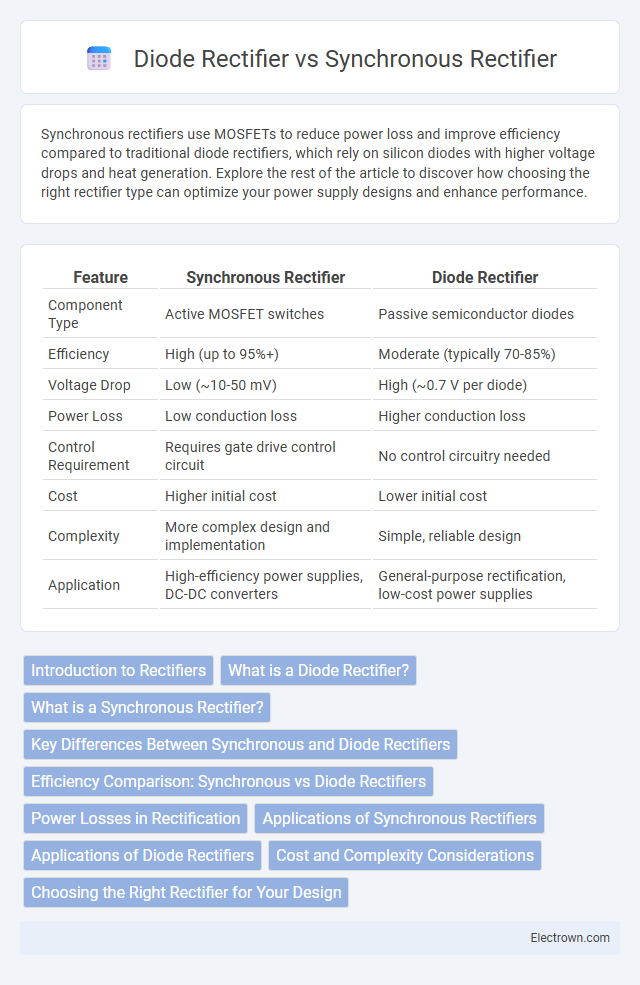Synchronous rectifiers use MOSFETs to reduce power loss and improve efficiency compared to traditional diode rectifiers, which rely on silicon diodes with higher voltage drops and heat generation. Explore the rest of the article to discover how choosing the right rectifier type can optimize your power supply designs and enhance performance.
Table of Comparison
| Feature | Synchronous Rectifier | Diode Rectifier |
|---|---|---|
| Component Type | Active MOSFET switches | Passive semiconductor diodes |
| Efficiency | High (up to 95%+) | Moderate (typically 70-85%) |
| Voltage Drop | Low (~10-50 mV) | High (~0.7 V per diode) |
| Power Loss | Low conduction loss | Higher conduction loss |
| Control Requirement | Requires gate drive control circuit | No control circuitry needed |
| Cost | Higher initial cost | Lower initial cost |
| Complexity | More complex design and implementation | Simple, reliable design |
| Application | High-efficiency power supplies, DC-DC converters | General-purpose rectification, low-cost power supplies |
Introduction to Rectifiers
Rectifiers are essential components in power electronics, converting alternating current (AC) to direct current (DC) for various applications. Synchronous rectifiers utilize MOSFETs controlled by switching circuits to reduce power loss and increase efficiency compared to traditional diode rectifiers, which rely on semiconductor diodes to perform rectification with higher voltage drops. Your choice between synchronous and diode rectifiers impacts overall system efficiency, especially in low-voltage, high-current power supplies.
What is a Diode Rectifier?
A diode rectifier is a semiconductor device that converts alternating current (AC) to direct current (DC) by allowing current to flow only in one direction through its p-n junction. It is widely used in power supplies and electronic circuits to achieve efficient AC to DC conversion with minimal energy loss. Your choice between a diode rectifier and synchronous rectifier depends on factors like efficiency, cost, and switching speed requirements.
What is a Synchronous Rectifier?
A synchronous rectifier is an advanced type of power converter that replaces traditional diodes with actively controlled MOSFETs to improve efficiency by minimizing voltage drops during rectification. Unlike diode rectifiers, which rely on the forward voltage drop of semiconductor junctions, synchronous rectifiers use precise timing to switch the MOSFETs, reducing conduction losses and enhancing your power supply's overall performance. This technology is especially beneficial in low-voltage, high-current applications where efficiency and heat dissipation are critical factors.
Key Differences Between Synchronous and Diode Rectifiers
Synchronous rectifiers use MOSFETs to replace diodes, significantly reducing power loss due to their low on-resistance compared to the inherent forward voltage drop in diode rectifiers. This results in higher efficiency, especially in low-voltage, high-current applications such as power supplies and DC-DC converters. Choosing a synchronous rectifier for your circuit can improve thermal performance and energy savings, making it a superior alternative to traditional diode rectifiers.
Efficiency Comparison: Synchronous vs Diode Rectifiers
Synchronous rectifiers achieve higher efficiency than diode rectifiers by replacing diodes with low-resistance MOSFETs, significantly reducing forward voltage drops and conduction losses. This efficiency gain is especially notable in low-voltage, high-current applications such as DC-DC converters and power supplies. Diode rectifiers suffer from fixed forward voltage drops (typically 0.7V for silicon diodes), which leads to greater power dissipation and reduced overall system efficiency compared to synchronous rectification.
Power Losses in Rectification
Synchronous rectifiers significantly reduce power losses compared to traditional diode rectifiers by using low-resistance MOSFETs instead of diodes, which have a higher forward voltage drop. This reduction in voltage drop lowers conduction losses during rectification, making synchronous rectifiers more efficient for power conversion, especially in high-current applications. Optimizing your design with synchronous rectification can greatly improve overall energy efficiency and thermal management.
Applications of Synchronous Rectifiers
Synchronous rectifiers are widely used in high-efficiency power supply designs such as DC-DC converters, laptop chargers, and server power modules due to their lower voltage drop and reduced power loss compared to diode rectifiers. These rectifiers significantly improve energy efficiency in applications requiring high current and low voltage conversion, including telecommunications equipment and electric vehicle battery management systems. They are preferred in scenarios demanding high-performance power management with minimal heat dissipation and enhanced overall system reliability.
Applications of Diode Rectifiers
Diode rectifiers are widely used in low-cost, low-frequency applications such as power supplies for household electronics, battery chargers, and simple AC to DC conversion circuits. Their robustness and simplicity make them ideal for environments where efficiency is less critical but reliability and ease of implementation are prioritized. These rectifiers are also common in transformer secondary rectification and in circuits where minimal switching noise is essential.
Cost and Complexity Considerations
Synchronous rectifiers use MOSFETs instead of diodes, which significantly reduces conduction losses but increases system complexity and initial cost due to the need for gate drive circuits and precise control. Diode rectifiers are simpler and cheaper, requiring no active control, making them ideal for low-cost, low-performance applications. Your choice depends on balancing efficiency gains against increased design complexity and upfront expenses.
Choosing the Right Rectifier for Your Design
Choosing the right rectifier for your design involves evaluating efficiency, cost, and thermal management, where synchronous rectifiers provide higher efficiency due to lower conduction losses compared to traditional diode rectifiers. Synchronous rectifiers use MOSFETs controlled by the circuit, reducing voltage drops and heat generation, which is crucial for high-current, low-voltage applications. Your design benefits from synchronous rectifiers in battery-powered or energy-sensitive systems, while diode rectifiers remain suitable for simpler, lower-cost solutions.
synchronous rectifier vs diode rectifier Infographic

 electrown.com
electrown.com